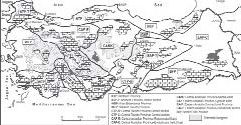Review of Turkish Karst with Emphasis on Tectonic and Paleogeographic Controls
DOI:
https://doi.org/10.3986/ac.v32i2.349Abstract
This paper re-evaluates the karst phenomenon in Turkey basing on the controlling factors such as, the source of energy gradient, lithostratigraphy, type of erosion base and climate. Two major karst types described are a) evolutionary karst which implies continuous karstification but at different stage of maturation and b)rejuvenated karst which is formed by reactivating a formerly developed and subsequently ceased karst structure either by an uplift and/or a drastic decline of erosion base. Description of karst types considering both morphology and hydrogeology revealed that distribution of specific karst types is compatible with the neotectonic evolution of Turkey. Karst in all provinces except the Black Sea and Western Anatolian regions, is developed under the effect of the energy gradient provided by uplift. Different rates of uplift created different sub-types of karst. The climate effect was evaluated as a secondary factor for it has a role of shaping/re-shaping the karst forms rather than controlling the physical and chemical processes.
Downloads

Downloads
Published
How to Cite
Issue
Section
License
Authors guarantee that the work is their own original creation and does not infringe any statutory or common-law copyright or any proprietary right of any third party. In case of claims by third parties, authors commit their self to defend the interests of the publisher, and shall cover any potential costs.
More in: Submission chapter




